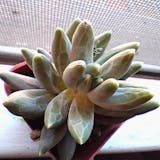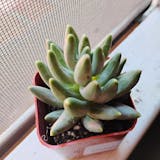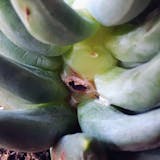About Pachyphytum compactum
Pachyphytum compactum, also considered as 'Little Jewel,' features dense rosettes characterized by thick, fleshy leaves. These leaves, often triangular or lanceolate in shape, exhibit an attractive bluish-green hue. Additionally, the edges of the leaves boast a captivating reddish or purplish tinge, further enhancing the plant's aesthetic charm. With a clumping or branching growth habit, Pachyphytum compactum forms multiple rosettes that cluster together, resulting in a visually striking and compact arrangement.
How to care for Pachyphytum compactum
Sunlight/Temperature: Pachyphytum compactum loves full sun, with some shade during the hottest part of the day. Good light exposure helps to keep the plants compact and encourages leaf color and flowering. A spot near a window with sheer curtains or under a shade cloth outdoors is ideal. And it prefers moderate temperatures that range from 60°F to 75°F. With enough temperature swings, the succulent will show its gorgeousness to you.
Watering: Pachyphytum compactum is a succulent with low water requirements. Water it regularly in summer, but remember to reduce watering during winter months. Allow the soil to dry out between waterings. Avoid placing the plant in standing water, as it can probably cause root rot. To determine the appropriate watering time for the succulent, observe the bottom leaves for signs of dehydration. When the plant requires water, these leaves may exhibit slight wilting and appear less plump or fleshy.
Soil and Pots: Use well-draining soil specifically formulated for succulents or cacti. A mix that contains a combination of materials like peat moss, perlite, and coarse sand provides good drainage. For transplanting these succulent plants, it is recommended to do so during the transition from late winter to early spring. When selecting a new pot, it is advisable to maintain the same size or choose one slightly larger, as Pachyphytum tends to grow to a height of less than one foot.
Propagation: Pachyphytum compactum can be propagated through stem or leaf cuttings. Take a stem cutting from the main plant, allow it to callus for a few days, and plant it in well-draining soil. Keep the soil lightly moist until roots develop. The leaves of this plant have a tendency to detach effortlessly from the stem, but they quickly develop roots from the base and give rise to young plantlets. Gently twist or cut a healthy leaf from the plant, and the treatment of stem cutting followed can also be applied to leaf propagation.
More information
Primary color: green
Secondary color: pink and orange
Bloom color: yellow or pale pink
Cold hardiness: zone 9a to 11b (20°F to 50°F)
Product format: 2'' pot
Suitability: container gardens, rock gardens
Propagation: leaf propagation, stem propagation
Special characteristic: easier to become crested






